Far afield from the Holy Land’s well-beaten tourist circuit of Tel Aviv – Jerusalem — Dead Sea, Ramot Menashe just south of Haifa offers visitors an experience of Israel at its natural finest with forests and fields, springs and streams, and rural communities. According to UNESCO, Ramot Menashe “encompasses a mosaic of ecological systems that represent the Mediterranean Basin’s version of the global evergreen sclerophyllous forests, woodlands and scrub ecosystem types” and in 2011 the 20,000 acre region was declared a Biosphere Reserve, where limitations are set on development and nature will forever be protected.

Photo: Bill Strubbe
To the north of Kibbutz Ein Hashofet rises the Carmel range, the monastery on Muchraka perched on its crag. Across the Jezerel Valley Nazareth sprawls like white frosting across the hills, while off to the west the sun glistens as it sets over the Mediterranean Sea. In decades past I’ve always visited my kibbutz in the searing summers when the hills are desiccated to a parched brown. I’d forgotten the chilly, rainy months that meld into a verdant spring, the meadows and woods a profusion of flowers: diminutive crimson tulips, party-colored anemones, scarlet poppies, purple irises, and delicately scented cyclamens.
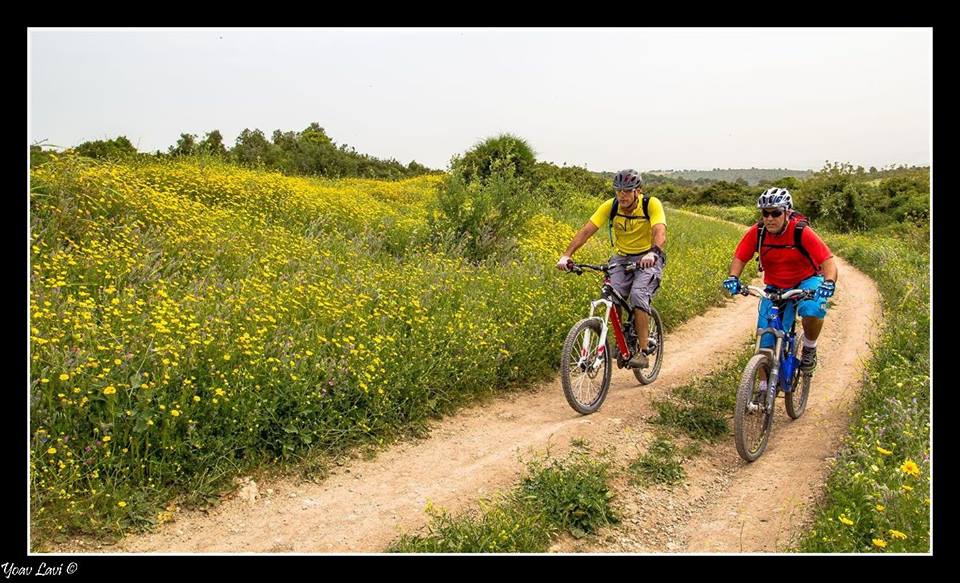
Botz Bike Excursions (Photo: Yoav Lavi)
It’s here in these lush hills of blooms that Adar Shadmi and his brother Arnon began as teens riding mountain bikes along the roads and dirt paths, eventually founding a biking company, Botz Bike (Botz in Hebrew means “mud”; plenty of that in winter!) In addition to the 1000 kilometers of existing dirt trails, 31 kilometers of well- maintained bike paths were recently developed in the area. On week-ends, thousands of Israelis flock here to ride the tracks looping through the forest, especially Cyclamen Hill covered with thousands the wild flowers in winter.
“Within Ramot Menashe we have a Twelve Springs Tour,” explains Adar from the porch of his modest kibbutz apartment. “In about four hours we visit Nahal Shofet, Nahal Karen, and Nahal Tahanim. Some of the springs are quite small, but when flowing enough the bikers stop and take a welcome dip.”
Botz Bike also offers trips throughout Israel, rides lasting from two days to one week, varying from easy to bust-ass. Botz does offer group tour dates, but most cyclists approach them with proposed trip and Botz arranges the details, places to sleep and eat, and vehicles to carry bags. “We do have a website,” Adar says, “but within Israel most of our business is by word of mouth.”
In summer, the trips in northern Israel begin early because even here by noon the thermometer quickly rises. In the winter, operations shift south to the Negev, taking advantage of the warm winter days, vast wilderness and endless off-trail options. Botz’s full-moon desert night rides — the light colored sand and stones reflecting the moonlight — are extremely popular.
Additionally, Botz Bikes expanded into scheduled trips to Europe, including Romania, Slovenia, Armenia, Georgia, France, and Scotland. “All of our clients are insured, and if something serious should happen to them, they can be flown back to Israel.”
In a fortuitous development helping expand Botz’s business, 100 kilometers of bike paths were created within Tel Aviv and surrounding cities, connecting urban, suburban and agricultural areas. The government is also constructing the Israel Trail extending from Mt. Hermon to Eilat. The southern portion was recently completed; the northern part slated to be finished within two years.
“This fall we plan to unveil our Cross Israel Trail,” explains Adar. “We’ll divide it into twenty segments, passing by arts and crafts places, wineries, cheese makers, and other tasty food stops. Every month people can ride one or two sections. In the north and south it will be two- or three-day rides; in the central region they’ll be just one day. People who ‘subscribe’ to the whole year receive a discount, or they can pay only for the segments that interest them.”
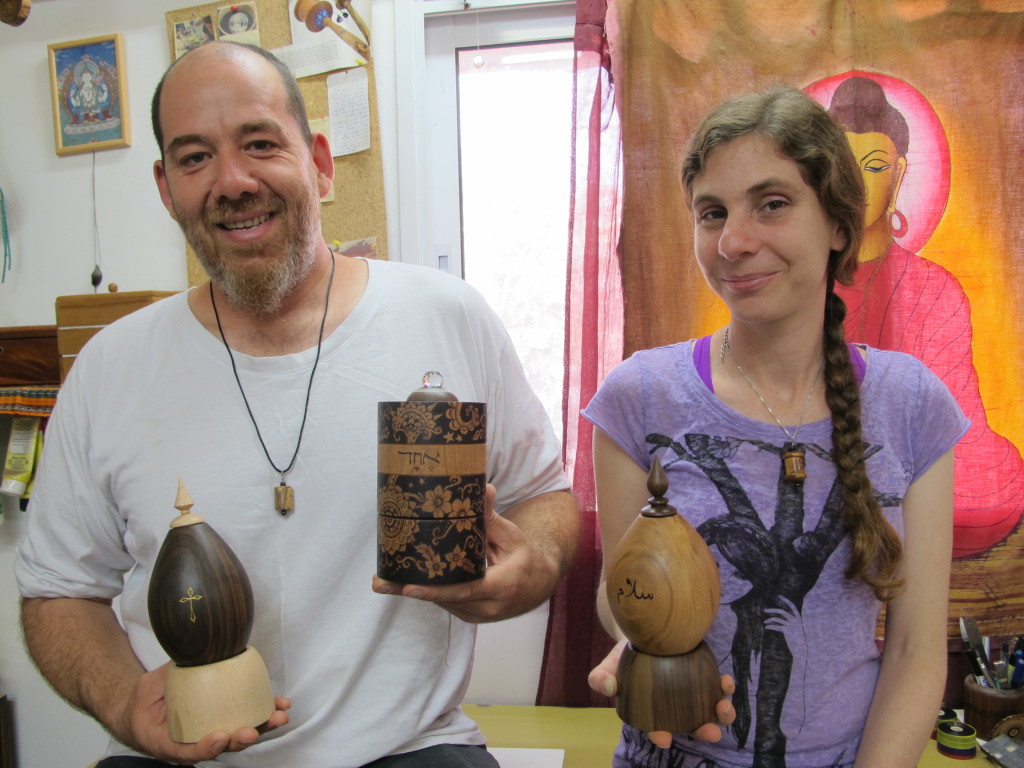
Prayer Wheels of Compassion (Photo: Bill Strubbe)
Not far from Kibbutz Ein Hashofet’s dining room, just below the grain silo in one of the old chicken runs, Micah Strauss works on a wood lathe in the back room, while Ayelet Cohen concentrates painting gold Sanskrit letters on a nearly completed prayer wheel. These Buddhist devotional devices are not something one would expect on a highly secular kibbutz, but times have changed with several kibbutz members now donning kippas, weekly yoga and Torah study classes, and several practicing Buddhists, Micah and Ayelet among them.
I first knew Micha as a mere toddler; now he’s in his early 40’s, and his partner Ayelet, from Kibbutz Yechiam, both believe it was their destiny to create prayer wheels together. In 2009, the Tibetan Buddhist teacher, Garchen Rinpoche, was conducting a seminar in Israel. “Garchen held a prayer wheel with gold lettering and a crystal on top,” recalls Ayelet. “Micah and I looked at each other and we both immediately knew we needed to make them.” Within several months they had constructed their first; the inception of their home business.
“Making prayer wheels is among the holiest thing a Buddhist can do; to spread joy, love and compassion,” Micah explains. “For seven kilometers in every direction, all beings are freed from the lower levels and from seven rebirths. Just to see a prayer wheel is a huge blessing.”
The workshop shelves display hand-held models, table-top prayer wheels, small pendant versions, as well as wooden dreidels, bowls, candle holders, boxes, and wall ornaments. The table-top wheels are particularly striking, some oval shaped with delicate spires; others cylindrical, some etched or stained with color. A variety of woods are employed, including olive, cherry, mahogany, African walnut, and purple heart wood sporting a lovely lavender tint.
In a lucky turn, shortly after they began making prayer wheels, a friend asked if they would like copies of microfilm with Buddhist mantras. Within one frame are some 11,000 seven-line prayers. “It was such stroke of luck, or karma,” Ayelet says as she shows me the microfilm. “Pieces are cut, rolled up tight and placed inside, each Buddhist prayer wheel containing 10-50 million mantras.”
I notice prayer wheels etched with crosses, others with Hebrew or Arabic lettering. Micah and Ayelet have expanded the prayer wheel concept to other faiths. Inside the Jewish ones is written the Shema or Ana B’koach prayers. In the Christian ones, it’s the Lord’s Prayer in Greek and Latin. They will create a prayer wheel for any spiritual faith requested.
Micah showed a Jewish man of the Breslever tradition the prayer wheel and he loved the idea, but said they must not write anything holy outside, and the prayer inside must be properly sealed enabling it to be worn in the bedroom and bathroom, in keeping with Jewish law. Micha also met with a Chabad-Lubavitcher rabbi who was encouraging.
When asked how he keeps the work from becoming boring, Micah replied, “I try to remember beginners mind, what it was like when I made the very first one. It was so sacred and holy. I try to keep that attitude alive, and also remember that this particular prayer wheel will be with one special person for many years.”
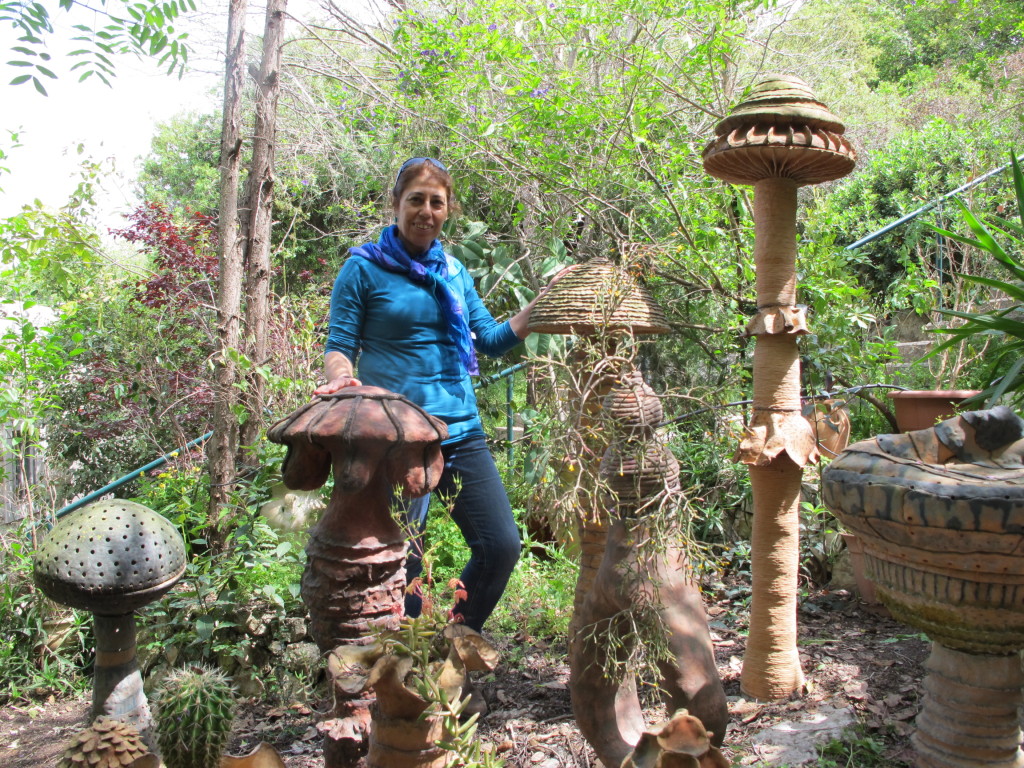
Israels Mushroom Queen (Photo: Bill Strubbe)
When I arrived before Purim to my kibbutz, an acquaintance told me, “I met someone recently and when she heard I was from Ein Hashofet, she asked ‘Do you happen to remember a volunteer named Bill who was at your kibbutz some 35-40 years ago?’” Though I had long ago lost track of Daliyah, I’d thought of her many times, but had no idea how to find her. I immediately called, and a few days later we had a happy reunion where I quickly learned she is Israel’s foremost mycologist.
Born in Tivon, and now living in Timrat, among Daliyah’s most vivid early memories is that of her school teacher who took them on outings in the nearby woods. “She brought along a huge basket and by the time we returned it was full of orniot mushrooms,” Daliyah says. “We would clean them and make soup, and ever since then I was curious about mushrooms.”
She also realized that parents and adults seemed “terribly afraid of mushrooms,” which made Daliyah understand that people are afraid of things they don’t understand. With few experts in Israel, she decided to learn everything she could about the fungi. She went on to study with Avizohar Hirshenson, a well-known Israeli mycologist educated at the Sorbonne. “Until then, mushrooms were my hobby, but then I decided to do my doctorate on Pleurotis eryngii, a mushroom common from the Golan Heights to the Negev Desert.”
In 1996, she was awakened by a call from a doctor with a patient who had eaten a poisonous mushroom asking Daliyah help to determine how to treat him. “It was turned out to be a big deal and I ended up on TV,” Daliyah laughs. “After that I became the point person for mushroom poisoning and every winter my phone started ringing.” In the 1990s, mushrooms poisoning skyrocketed – about 30-40 people per year – with the wave of Russian immigration. (Collecting edible mushrooms has long been part of Russian culture and diet.) In one Russian family, the father was hospitalized for seven days; the baby returned home after nineteen days.
Daliyah realized the need to educate the public about identifying mushrooms, to establish boundaries to make it a safe hobby, and she wrote a book and she began giving talks and walking tours through-out the country, especially in Ramot Menashe forests. “On my excursion, I usually teach people how to distinguish three or four types of mushrooms,” she explains. “You will be 100% certain, as certain as distinguishing a tomato from a cucumber, that they are safe and you can eat them.”
The three best tasting and easiest to identify are: the Orniot, suillas granulatas, which grow only in pine forests; Lepista nuda, a pale purple mushroom that grows under many types of trees; and the Volvariella speciosu that grows only in fields. But Daliyah’s favorite, taste wise, is the Pleurotus ostreatus (oyster mushroom) which grows only on trees.
Her mushroom book is so sought-after that she was once offered 1000 shekels (about $250) by an avid mushroom enthusiast for her last remaining copy. “A woman once told me that she was very lucky because she had my book with her and she realized a mushroom she was about to eat was poisonous.” Happily, a second edition is scheduled for the Fall of 2015.
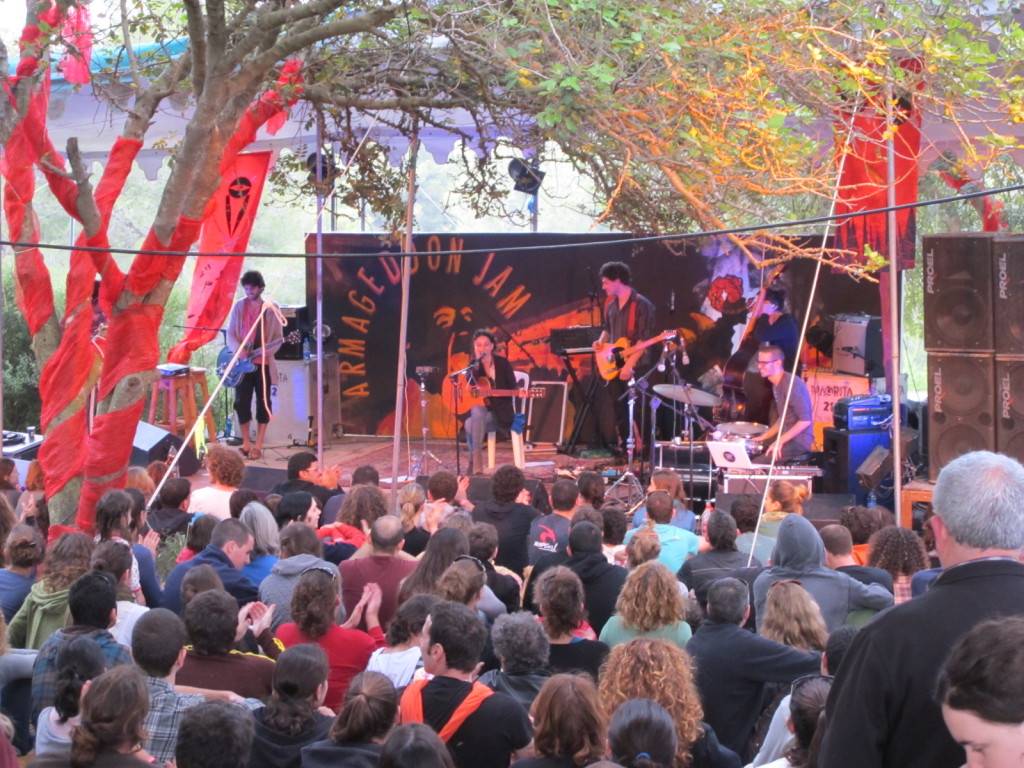
Rockin’ in the Woods (Photo: Bill Strubbe)
Juggling, hula hoop and slackline sessions, a library in the forest, zany art installations, modern dance among the trees, spoken word sessions, video zones, kids theater, circus acts and clowning…. And oh yes, hours and hours of rockin’ music from some of Israel’s outstanding alternative stars set in the Menashe Forest between Kibbutz Mishmar H’Emek and Kibbutz Ein Hashofet.
In early May, when the weather warms, several thousand music fans throng to the annual Yearot Festival, one of the most acclaimed indie culture festivals in Israel. It originally started as a local event, but has since garnered raves from fans all over Israel and an increasing number of tourists, growing more popular every year draw-ing a diverse audience of all ages.
On the three stages, the festival draws a cohort of the most innovative and interest-ing musicians in Israel such as Geva Alon, the Armageddon Jam Allstars, Victoria Hannah, Yehuda Keizer, Aviv Noiman, The Ramirez Brothers, Buttering Trio, and Labrador Laboratories, and Hadag Nachash, as well as guest international bands.
The unique Up-A-Tree stage venue is for artists without a fear of heights, where soloists and duos, singer-songwriters, and spoken word artists perform for the audience gathered below. Every evening, the Video Zone screens student films, music and documentary films and video art. Connecting cutting edge music to nature and science, the Department of Biology and Ecology of Oranim College and the University of Haifa establish an experimental field lab, sponsoring lectures and guided walks discussing the local habitat and ecological issues.
There’s a free onsite campground with outdoor showers (bring a bathing suit!) and other basic facilities. Thanks to its ever-growing popularity, buses shuttle to and from Tel Aviv. But if you really want to get nature-friendly, the Ramot Menashe Trail is marked so that you can hike in from miles away to the site. Mobile toilets and camping sites are set up along the trail a week before the festival.
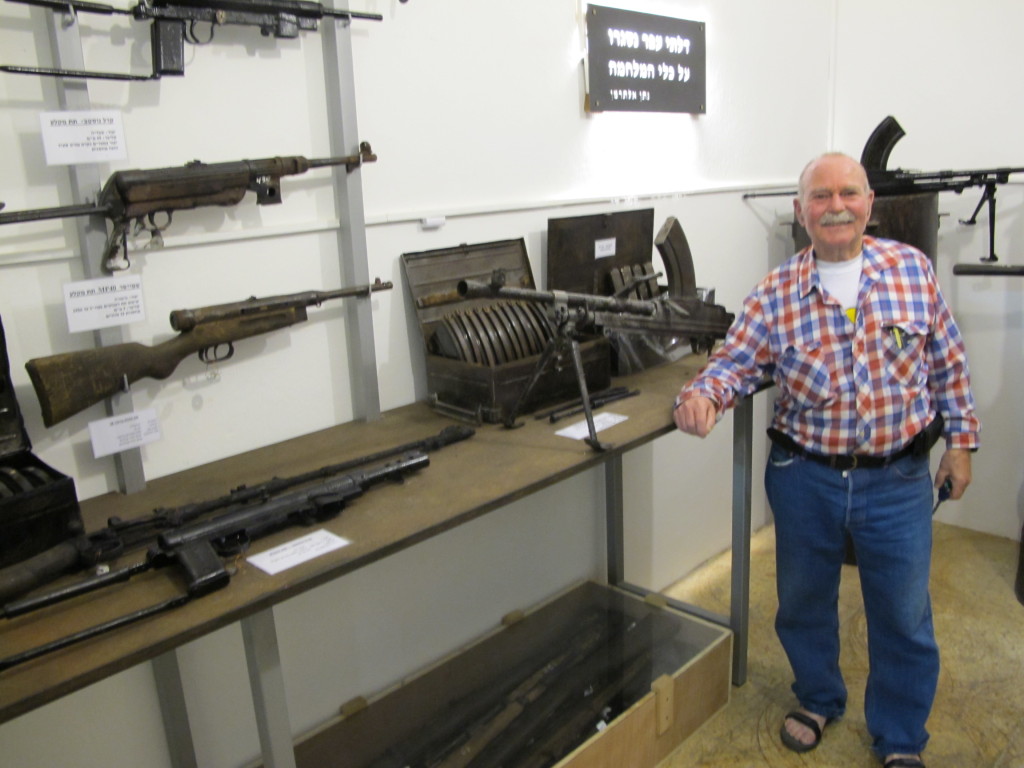
Eishi and the Fabulous Slick (Photo: Bill Strubbe)
When visiting my kibbutz, I regularly work out in the modest fitness room, never sus-pecting what lay directly beneath the treadmills and barbells. For decades, since the end of the British Mandate in 1948, there was rumored to be hidden on the kibbutz a slick (cache of weapons), the object of much speculation and searches by the kibbutz young people, but all in vain.
In 2009, a 96-year-old founding member kibbutznik and former regional commander in the Hagannah,, Beryl Kremer, broke 64 years of silence and revealed the location of the slick. Sworn to secrecy, Keren was the last of the eight men alive who knew of the location, and finally decided – no one could understand why he waited so long — to reveal the secret to Eishi Ubermam. Eishi, now 75, was among the first group of children born on the kibbutz who dreamed of discovering the cache. The problem was that Beryl couldn’t say exactly where under the floor of the former barn, then a chick-en coup, now fitness room the slick was located.
They pulled out old kibbutz maps, brought in underground sonar detection apparatus, and still it took months to uncover the opening. When they finally did, the weapons — dozens of rifles, hand guns, rounds of ammo, grenades, etc. – were half submerged in water that had seeped into the concrete bunker. The weapons had all been heavily greased, covered in greased clothe, stored inside huge metal tubes, and when un-wrapped all were miraculously in working order.
Now, every week-end, tour groups arrive, disembark from buses, and while sitting around the grated slick opening in the gym floor, listen to Eishi’s fascinating story of why it was created, how it was dug in secret in the dead of night, and how it was re-discovered. After a short video of Beryl Kremer being interviewed, and the elderly man being lowered — against the wishes of his family — down into the slick in a special cage, Eishi unlocks the weapons room for a viewing. Seemingly an odd subject for a tour, it‘s immensely popular, and with Eishi’s riveting storytelling it’s informative and funny, at the same time giving you a history of Israel’s early years.
Zohar Badeshe, located on Kibbutz Dalia amidst the Menashe Hills, is a rural guest house featuring fifteen wooden chalets with fully equipped kitchenettes, and ten rooms for couples or business guests. The stay includes a hearty kosher breakfast of fresh salads, bread, olives and jams as well as special cheeses. Kosher lunch and dinners are also an option at the Zohara Restaurant. In Kibbutz Dalia are playgrounds for kids, a sculpture garden, nature paths, boutique winery, swimming pool (in seasons), grocery store, bike rentals, and a mini-golf lane.